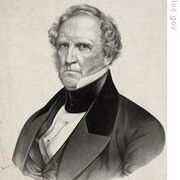
Winfield Scott.
The Burgoyne Conference of 1842 was a special session of the Grand Council called for the purpose of amending the Britannic Design of 1781 to remake the Confederation of North America from a loose confederation of British colonies into a unified nation.
The Burgoyne Conference had its origins in the Concordia and Brant Conventions of 1841, where delegates from the two major parties of the various confederations met together to deal with the common problems associated with the Panic of 1836. Both conventions called for the Britannic Design to be amended to bring the confederations into a closer and stronger union. In November 1841, Viceroy Sir Alexander Haven agreed to submit the conventions' resolves to the Crown. In London, both Queen Victoria and Prime Minister Sir Duncan Amory favored the proposal, and in January 1842 Parliament agreed to the convening of a special session of the Grand Council to consider amendments to the Britannic Design.

Willie Lloyd.
The Grand Council met in Burgoyne from July to September 1842, with General Winfield Scott of Indiana at the head of the Unified Liberal members and Governor Willie Lloyd of South Carolina representing the National Conservatives. Although Scott and Lloyd favored different policies, they were able to work together to draft amendments which were ratified by large majorities of the Grand Council.
The first amendment adopted by the Burgoyne Conference transformed the Grand Council into a popularly elected national legislature, and created a Confederation Senate to represent the confederations. The second amendment created the office of Governor-General, chosen by majority vote of the Grand Council, to serve as chief executive, with the Viceroy serving as a figurehead Head of State. Other amendments reaffirmed the C.N.A.'s subordination to the British Crown, affirmed the right of the British government to call upon the C.N.A.'s military to defend the British Empire, and affirmed the Anglican Church as the established church of the C.N.A.
Neither Queen Victoria nor Prime Minister Amory raised any significant objections to the amendments adopted by the Burgoyne Conference, and the amended political structure of the C.N.A., known as the Second Britannic Design, was confirmed by Parliament later in 1842. Elections for the new Grand Council were held on February 15, 1843, and the first Governor-General was chosen shortly afterwards.
Sobel's sources for the Burgoyne Conference are Fanny Lever's The Second Britannic Design (New York, 1850), Dickinson Letts' Origins of the Two Party System (New York, 1923), Valentine Edwardson's The Burgoyne Conference of 1842 (Canberra, 1960), and Adolph Anderson's The Rise of the C.N.A. (London, 1967).
